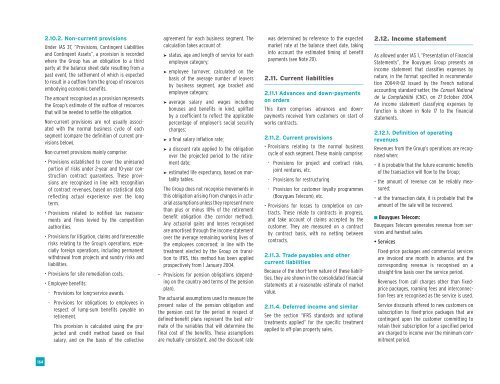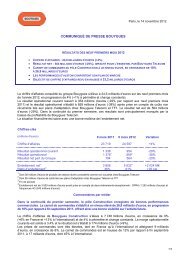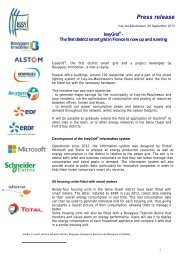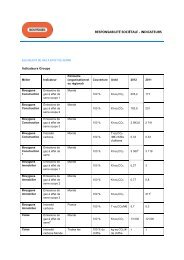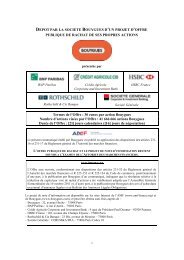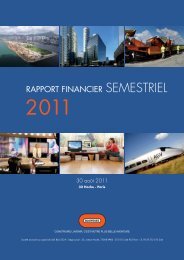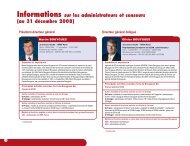A N N U A L R E P O R T - Bouygues
A N N U A L R E P O R T - Bouygues
A N N U A L R E P O R T - Bouygues
You also want an ePaper? Increase the reach of your titles
YUMPU automatically turns print PDFs into web optimized ePapers that Google loves.
2.10.2. Non-current provisions<br />
Under IAS 37, “Provisions, Contingent Liabilities<br />
and Contingent Assets”, a provision is recorded<br />
where the Group has an obligation to a third<br />
party at the balance sheet date resulting from a<br />
past event, the settlement of which is expected<br />
to result in a outflow from the group of resources<br />
embodying economic benefits.<br />
The amount recognised as a provision represents<br />
the Group’s estimate of the outflow of resources<br />
that will be needed to settle the obligation.<br />
Non-current provisions are not usually associated<br />
with the normal business cycle of each<br />
segment (compare the definition of current provisions<br />
below).<br />
Non-current provisions mainly comprise:<br />
• Provisions established to cover the uninsured<br />
portion of risks under 2-year and 10-year construction<br />
contract guarantees. These provisions<br />
are recognised in line with recognition<br />
of contract revenues, based on statistical data<br />
reflecting actual experience over the long<br />
term.<br />
• Provisions related to notified tax reassessments<br />
and fines levied by the competition<br />
authorities.<br />
• Provisions for litigation, claims and foreseeable<br />
risks relating to the Group’s operations, especially<br />
foreign operations, including permanent<br />
withdrawal from projects and sundry risks and<br />
liabilities.<br />
• Provisions for site remediation costs.<br />
• Employee benefits:<br />
- Provisions for long-service awards.<br />
- Provisions for obligations to employees in<br />
respect of lump-sum benefits payable on<br />
retirement.<br />
This provision is calculated using the projected<br />
unit credit method based on final<br />
salary, and on the basis of the collective<br />
agreement for each business segment. The<br />
calculation takes account of:<br />
➤ status, age and length of service for each<br />
employee category;<br />
➤ employee turnover, calculated on the<br />
basis of the average number of leavers<br />
by business segment, age bracket and<br />
employee category;<br />
➤ average salary and wages including<br />
bonuses and benefits in kind, uplifted<br />
by a coefficient to reflect the applicable<br />
percentage of employer’s social security<br />
charges;<br />
➤ a final salary inflation rate;<br />
➤ a discount rate applied to the obligation<br />
over the projected period to the retirement<br />
date;<br />
➤ estimated life expectancy, based on mortality<br />
tables.<br />
The Group does not recognise movements in<br />
this obligation arising from changes in actuarial<br />
assumptions unless they represent more<br />
than plus or minus 10% of the retirement<br />
benefit obligation (the corridor method).<br />
Any actuarial gains and losses recognised<br />
are amortised through the income statement<br />
over the average remaining working lives of<br />
the employees concerned; in line with the<br />
treatment elected by the Group on transition<br />
to IFRS, this method has been applied<br />
prospectively from 1 January 2004.<br />
• Provisions for pension obligations (depending<br />
on the country and terms of the pension<br />
plan).<br />
The actuarial assumptions used to measure the<br />
present value of the pension obligation and<br />
the pension cost for the period in respect of<br />
defined-benefit plans represent the best estimate<br />
of the variables that will determine the<br />
final cost of the benefits. These assumptions<br />
are mutually consistent, and the discount rate<br />
was determined by reference to the expected<br />
market rate at the balance sheet date, taking<br />
into account the estimated timing of benefit<br />
payments (see Note 20).<br />
2.11. Current liabilities<br />
2.11.1 Advances and down-payments<br />
on orders<br />
This item comprises advances and downpayments<br />
received from customers on start of<br />
works contracts.<br />
2.11.2. Current provisions<br />
• Provisions relating to the normal business<br />
cycle of each segment. These mainly comprise:<br />
- Provisions for project and contract risks,<br />
joint ventures, etc.<br />
- Provisions for restructuring<br />
- Provision for customer loyalty programmes<br />
(<strong>Bouygues</strong> Telecom), etc.<br />
• Provisions for losses to completion on contracts.<br />
These relate to contracts in progress,<br />
and take account of claims accepted by the<br />
customer. They are measured on a contract<br />
by contract basis, with no netting between<br />
contracts.<br />
2.11.3. Trade payables and other<br />
current liabilities<br />
Because of the short-term nature of these liabilities,<br />
they are shown in the consolidated financial<br />
statements at a reasonable estimate of market<br />
value.<br />
2.11.4. Deferred income and similar<br />
See the section “IFRS standards and optional<br />
treatments applied” for the specific treatment<br />
applied to off-plan property sales.<br />
2.12. Income statement<br />
As allowed under IAS 1, “Presentation of Financial<br />
Statements”, the <strong>Bouygues</strong> Group presents an<br />
income statement that classifies expenses by<br />
nature, in the format specified in recommendation<br />
2004-R-02 issued by the French national<br />
accounting standard-setter, the Conseil National<br />
de la Comptabilité (CNC), on 27 October 2004.<br />
An income statement classifying expenses by<br />
function is shown in Note 17 to the financial<br />
statements.<br />
2.12.1. Definition of operating<br />
revenues<br />
Revenues from the Group’s operations are recognised<br />
when:<br />
• it is probable that the future economic benefits<br />
of the transaction will flow to the Group;<br />
• the amount of revenue can be reliably measured;<br />
• at the transaction date, it is probable that the<br />
amount of the sale will be recovered.<br />
■ <strong>Bouygues</strong> Telecom:<br />
<strong>Bouygues</strong> Telecom generates revenue from services<br />
and handset sales.<br />
• Services<br />
Fixed-price packages and commercial services<br />
are invoiced one month in advance, and the<br />
corresponding revenue is recognised on a<br />
straight-line basis over the service period.<br />
Revenues from call charges other than fixedprice<br />
packages, roaming fees and interconnection<br />
fees are recognised as the service is used.<br />
Service discounts offered to new customers on<br />
subscription to fixed-price packages that are<br />
contingent upon the customer committing to<br />
retain their subscription for a specified period<br />
are charged to income over the minimum commitment<br />
period.<br />
164


